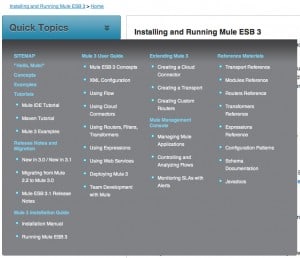I was recently tasked with revamping the developer documentation’s information architecture to address reader comments that it was too hard to find needed information. I worked with a team of people at MuleSoft to make the new information architecture a reality, as well as to write some new content that helped explain Mule ESB 3 concepts for new users, as well as to improve the quality of key topics in the docs and to write a new document, Hello, Mule!, to help new users quickly download and install Mule CE and the IDE and to get their Mule installation up and running in minutes. Here’s a link to the new documentation.
In a nutshell, here’s what we did:
- Reorganized content into books.
- Grouped topics within the Users Guide into a much more intuitive manner.
- Rewrote much of the conceptual and other material to explain the new concepts in Mule 3.
- Created new topics such as Using Mule With Web Services and Understanding Enterprise Integration Patterns Using Mule.
- Created Hello, Mule!, and put it through extensive usability testing.
- Created the Quick Topics navigation button. Try it out! Let me know if it helps you drill into the documentation and find topics you use frequently.
The major information architecture overhaul was to provide a book and topic architecture–we created a book for each major subject area in the documentation, including Concepts, Installation, Examples, Tutorial, User Guide, Migration Guide, and Reference. Then inside the books we logically ordered each explicitly named topic from most general to most specific for a more intuitive experience.
Quick Topics, the button that when pushed provides a large menu of linked topics that are often accessed by readers, looks like this when activated:
Because it contains links to nearly every book and often-accessed topics, you now have a facility for quickly hopping to a new topic you might need to read when in the middle of writing a large Mule application and heavily using the docs.
We hope you enjoy the new information architecture, topics, and navigation: if you have comments about it, good or bad, please email me.
I will be working tirelessly with the team over the coming months to continue to improve the documentation’s quality, both from a content and a style viewpoint. If you need a specific topic written for you, and we have enough requests for that topics, we can write it. Again, contact me if you have any comments about documentation quality and coverage.









